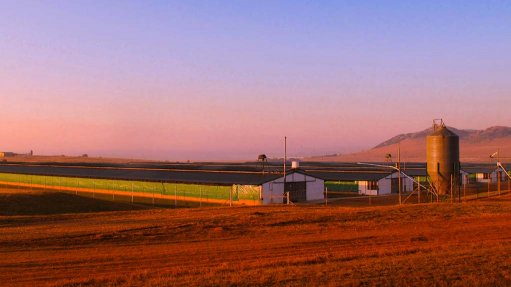Dry-cooled power stations
Once completed, Medupi will be both the fourth-largest power station and the biggest dry-cooled power station in the world. It will have a capacity of 4 764 MW. Dry-cooled power stations, as opposed to power stations which are cooled by steam or gas, are built mainly because of a shortage of cooling water at the construction site.
Ironically, the Medupi power station is being built at Waterberg. One would hope that Waterberg would contain water and also something to heat it, but it is what it is.
Sometime back (which is six years ago), Steve Caldwell and I went to the site to conduct a training session. This was necessary because, being a power station which is dry cooled, the operating staff didn’t understand the basic principles of operation. Not that the basic principles for a dry-cooled power station are terribly complicated – the basic principle is that the water circuit is cooled with a huge amount of air that is kept cool with a large number of fans.
It was a very interesting trip because the power station construction had started about 12 years earlier and the construction standard was very high. It so happened that the people who attended our training course were not very interested in the training as such and, while all of them came to the first gathering of trainees, they did not come to the second. This was a pity because they would have learnt something. On the other hand, Steve and I learnt a great deal.
The power station units were about 800 MW each. An 800 MW steam turbine is quite a beast. For example, (as I remember) it is about 20 m in diameter and 30 m long, if not longer. The bits of the machine which passed steam and electricity were equally large. I cannot remember the exact dimensions of the unit but suffice it to say that it impressed me at the time.
I have been told (but have not witnessed for myself) that the bits of the turbines and machinery have been altered to allow for the adoption of all the units as enclosed, or at least semi-enclosed, to prevent people from interfering with the machinery. This was not originally part of the design and, in fact, must greatly interfere with the safe operation of the system. It is a very interesting situation to examine – a system whereby some machinery is designed with one philosophy (unenclosed and open) which is then converted to a system of being semi-enclosed or completely enclosed. I must mention again that I have not witnessed the degree of enclosure myself. So, it’s perhaps less intensive than I have indicated.
As regards the degree to which the power station succeeds as one which works on dry-power cooling, the whole system is a great success. It is unfortunate that this is the only dry-cooled power station in South Africa (or, in fact, Southern Africa) since it operates to a high standard.
One of the benefits of dry-powered cooling is that you don’t have to place the power station at a source of cooling water. Thus, you are only limited by the location of the heat source. It is a fact that dry-cooled power stations are more expensive to operate and are more costly to construct than the alternatives – well, that was before the South African government showed us how much could be spent on power stations such as Kusile.
In retrospect, it would have been far more to the benefit of Eskom to have proceeded with the construction of future power stations as units which were based on dry power rather than units based on water cooling, as another benefit of dry-power construction is that one doesn’t have the issues related to the mining of coal and far simpler heat production.
A benefit which Steve and I managed to achieve at Medupi was that, on the last night we were there, we had a very good party. My head was still aching two days later.
Comments
Press Office
Announcements
What's On
Subscribe to improve your user experience...
Option 1 (equivalent of R125 a month):
Receive a weekly copy of Creamer Media's Engineering News & Mining Weekly magazine
(print copy for those in South Africa and e-magazine for those outside of South Africa)
Receive daily email newsletters
Access to full search results
Access archive of magazine back copies
Access to Projects in Progress
Access to ONE Research Report of your choice in PDF format
Option 2 (equivalent of R375 a month):
All benefits from Option 1
PLUS
Access to Creamer Media's Research Channel Africa for ALL Research Reports, in PDF format, on various industrial and mining sectors
including Electricity; Water; Energy Transition; Hydrogen; Roads, Rail and Ports; Coal; Gold; Platinum; Battery Metals; etc.
Already a subscriber?
Forgotten your password?
Receive weekly copy of Creamer Media's Engineering News & Mining Weekly magazine (print copy for those in South Africa and e-magazine for those outside of South Africa)
➕
Recieve daily email newsletters
➕
Access to full search results
➕
Access archive of magazine back copies
➕
Access to Projects in Progress
➕
Access to ONE Research Report of your choice in PDF format
RESEARCH CHANNEL AFRICA
R4500 (equivalent of R375 a month)
SUBSCRIBEAll benefits from Option 1
➕
Access to Creamer Media's Research Channel Africa for ALL Research Reports on various industrial and mining sectors, in PDF format, including on:
Electricity
➕
Water
➕
Energy Transition
➕
Hydrogen
➕
Roads, Rail and Ports
➕
Coal
➕
Gold
➕
Platinum
➕
Battery Metals
➕
etc.
Receive all benefits from Option 1 or Option 2 delivered to numerous people at your company
➕
Multiple User names and Passwords for simultaneous log-ins
➕
Intranet integration access to all in your organisation


















